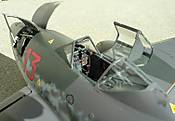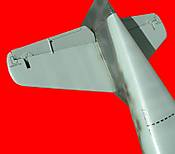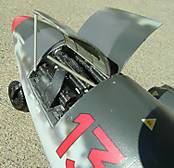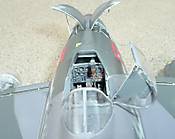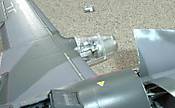1⁄32Song of the Swallow
2
Comments
STEP 31-35 Stabilizers, elevators, Rudder, Cockpit Deck, Canopy
All of these assemble straightforward. My control surfaces fit into the stabilizers was very tight. The windscreen has an armored glass to fit within. Trumpeter did a great job of molding these to fit easily. Be advised the armored glass has a frame you will need to paint prior to mounting. Black or RLM 66 would be my guess. The center canopy piece is shown with an armored headrest to mount now. It has a leather head pad. Trumpeter’s odd painting guide tells us the color of it in the subsequent step--after the parts are joined! I have only found one photo of an ME-262 with this item. Fitting astride the pilot’s seat is the decking for the turtleback. The stabilizers have interlocking tongues that fit through a slot in the tail. I had big gaps between them and the tail to fill and sand. The rudder fits nicely into the tailplane. This step directs one to glue on the gun bay access panels.STEP 36 Final Assembly
All three canopy pieces are mounted now. Dry fit these. Some minor problems. Windscreen: this piece's curvature has more arc than the fuselage contour, resulting in another step between parts. I glued the front and rear canopies first, then tried to seat opening center piece in the closed position. It didn’t fit well. I had to gently, carefully file the center piece to fit between the front and rear pieces. Be advised the center piece also has two tabs on the right side. Do not cut these off; they are for mounting it open. Photos show a lever mounted in the middle of this piece’s bottom frame, but this is absent from the kit. The rear canopy is to long. Not only does this squeeze the center piece, it extends beyond the turtledeck noticeably. To move it forward to avoid this leaves a hideous gap along the turtledeck, and squeezes the center piece even more. Lastly, add the radio bay hatch and, between the canopy and tail, the loop antenna.DECALS and CAMOFLAUGE
Supplied is a large painting and decaling guide in full color. The camouflage diagram takes the form of a large full-colour sheet and gives a full 4-view for Schall's aircraft, but only a port view for Novotny's. Both are camouflaged in RLM 81/82 topsides over RLM 76, while Novotny's machine features the distinctive stenciled pattern applied to the fin and rudder. Research your aircraft; some of the indicated placement may be faulty. Trumpeter’s decals are impressive. I like them as user-friendly. They may be a little thick compared to most a.m. products, but they are in registration, crisp, opaque, came right off the sheet, did not curl, stuck fast, dried clear, and did not suffer under Micro Set or Sol, nor Walther’s Solvaset. Tough, too, as I found out while applying the wing walkway borders and the “Lift Here” stenciling on the nose and the rear fuselage. Swastikas are provided and avoid laws prohibiting them by being printed in four parts apiece. One choice of Balkenkruz. Plenty of stenciling, maybe not factory complete, but enough. Even service stenciling for the tires and wheel hubs is provided. Black and red options for the wing walkway borders, with no indication of which is appropriate for either aircraft. Decals for two aircraft, Red 4 flown by Haupt. Franz Schall of 10/JG7 in April 1945, and White 8, W. Nr 110400 flown by Major Walter Novotny. I chose neither. Using Eagle Cal’s set (reviewed by Merlin) I built Heinz “Pritzl” Bar’s Red 13. While most Schwalben are depicted in late-war RLM 81/83/76, Eagle Cal’s state that Bar’s colors are uncertain, though its werk number was in a batch painted mid-war dayfighter 74/75/76. Monogram’s Official Luftwaffe Colors & Markings Guide verifies this. I used Polly Scale acrylics almost exclusively. My references state that some Schwalbe wore an undercoat of a light gray upon which the stenciling was painted. These areas were then masked to avoid the factory-applied standard camouflage over coating. Additionally, much of the stenciling was overpainted by field camouflaging.Conclusion:
I recommend this model. This kit builds into an excellent model of the revolutionary warplane. Despite the large number of parts, mixed media and some fit troubles; I believe it can be successfully built by modelers of even average experience, so long as the number of parts do not become overwhelming.Bio:
An accident testing a light plane over Germany in April 1957 claimed the life of a 44 year-old company test pilot. What enemy pilots and gunners were unable to achieve in over 1,000 combat sorties happened during a routine acceptance flight by the company test pilot, Heinz Bar. Oberstletnant Heinz “Pritzl” Bar started his career as a bomber pilot and flying JU-52 transports. “Pritzl” Bar, known as an exceptional shot, flew throughout the war, becoming the world’s eighth-ranking ace with 221 victories who flew more than 1000 missions. He himself was shot down or crash landed several times, once into the English Channel during the Battle of Britain, and once deep behind Russian lines. Roughly half of his kills were against the Western Allies; he downed 65 aircraft over the Mediterranean and North Africa, 22 four-engine bombers and is the second most successful ME-262 ace with 16 jet kills. He was known to act as the sole escort for his inexperienced pilots, to take off while his airfield was under attack, and fight rear guard actions to protect his pilots when they were low on fuel and ammo. His career was repressed after coming into Reichmarshal Goering’s displeasure. I have not yet read why, though Bar was known as cavalier, as well as to have protected a half-Jewish Jagdflieger, offering his own papers should the Gestapo interrogate the pilot. His first jet kill was a P-51 on 19 March 1945 after assuming command of III./EJG 2 at Lechfeld Schule, and ending the war with JV-44, Galland’s ME-262 “Squadron of Experten”. His personal Focke-Wulf 190s were emblazoned a large red 13 and 23, and “Red 13” was his personal ME-262.Comments
Hello Everyone,
I hope you enjoy my building review of my two sixty-two.
Additionally, here is Merlin's In-Box Review
and my building-in-progress 'blogs': Fred's In-progress Building Post URLs
Merlin also reviewed the Eagle Cal decals: Messerschmitt Me 262 Decal Sheets (1:32)
...and newly built flying Schwalben...OFFICIAL Me 262 PROJECT UPDATES
APR 11, 2006 - 03:50 AM
Copyright ©2021 by Fred Rick Boucher. Images also by copyright holder unless otherwise noted. The views and opinions expressed herein are solely the views and opinions of the authors and/or contributors to this Web site and do not necessarily represent the views and/or opinions of AeroScale, KitMaker Network, or Silver Star Enterrpises. Images also by copyright holder unless otherwise noted. Opinions expressed are those of the author(s) and not necessarily those of AeroScale. All rights reserved. Originally published on: 2006-04-10 00:00:00. Unique Reads: 22115




